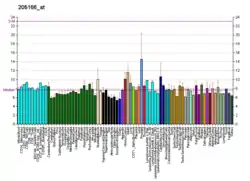CAPN5
Calpain-5 is a protein that in humans is encoded by the CAPN5 gene.[5][6][7]
| CAPN5 | |||||||||||||||||||||||||||||||||||||||||||||||||||
|---|---|---|---|---|---|---|---|---|---|---|---|---|---|---|---|---|---|---|---|---|---|---|---|---|---|---|---|---|---|---|---|---|---|---|---|---|---|---|---|---|---|---|---|---|---|---|---|---|---|---|---|
| Identifiers | |||||||||||||||||||||||||||||||||||||||||||||||||||
| Aliases | CAPN5, ADNIV, HTRA3, VRNI, nCL-3, calpain 5 | ||||||||||||||||||||||||||||||||||||||||||||||||||
| External IDs | OMIM: 602537 MGI: 1100859 HomoloGene: 31212 GeneCards: CAPN5 | ||||||||||||||||||||||||||||||||||||||||||||||||||
| |||||||||||||||||||||||||||||||||||||||||||||||||||
| |||||||||||||||||||||||||||||||||||||||||||||||||||
| |||||||||||||||||||||||||||||||||||||||||||||||||||
| |||||||||||||||||||||||||||||||||||||||||||||||||||
| |||||||||||||||||||||||||||||||||||||||||||||||||||
| Wikidata | |||||||||||||||||||||||||||||||||||||||||||||||||||
| |||||||||||||||||||||||||||||||||||||||||||||||||||
Calpains are calcium-dependent cysteine proteases involved in signal transduction in a variety of cellular processes. A functional calpain protein consists of an invariant small subunit and 1 of a family of large subunits. CAPN5 is one of the large subunits. Unlike some of the calpains, CAPN5 and CAPN6 lack a calmodulin-like domain IV. Because of the significant similarity to Caenorhabditis elegans sex determination gene tra-3, CAPN5 is also called as HTRA3.[7]
References
- GRCh38: Ensembl release 89: ENSG00000149260 - Ensembl, May 2017
- GRCm38: Ensembl release 89: ENSMUSG00000035547 - Ensembl, May 2017
- "Human PubMed Reference:". National Center for Biotechnology Information, U.S. National Library of Medicine.
- "Mouse PubMed Reference:". National Center for Biotechnology Information, U.S. National Library of Medicine.
- Matena K, Boehm T, Dear N (Apr 1998). "Genomic organization of mouse Capn5 and Capn6 genes confirms that they are a distinct calpain subfamily". Genomics. 48 (1): 117–20. doi:10.1006/geno.1997.5133. PMID 9503024.
- Mugita N, Kimura Y, Ogawa M, Saya H, Nakao M (Dec 1997). "Identification of a novel, tissue-specific calpain htra-3; a human homologue of the Caenorhabditis elegans sex determination gene". Biochem Biophys Res Commun. 239 (3): 845–50. doi:10.1006/bbrc.1997.7571. PMID 9367857.
- "Entrez Gene: CAPN5 calpain 5".
Further reading
- Vanderklish PW, Bahr BA (2001). "The pathogenic activation of calpain: a marker and mediator of cellular toxicity and disease states". International Journal of Experimental Pathology. 81 (5): 323–39. doi:10.1111/j.1365-2613.2000.00169.x. PMC 2517738. PMID 11168679.
- Sato K, Kawashima S (2002). "Calpain function in the modulation of signal transduction molecules". Biol. Chem. 382 (5): 743–51. doi:10.1515/BC.2001.090. PMID 11517927. S2CID 882390.
- Bonaldo MF, Lennon G, Soares MB (1997). "Normalization and subtraction: two approaches to facilitate gene discovery". Genome Res. 6 (9): 791–806. doi:10.1101/gr.6.9.791. PMID 8889548.
- Dear N, Matena K, Vingron M, Boehm T (1997). "A new subfamily of vertebrate calpains lacking a calmodulin-like domain: implications for calpain regulation and evolution". Genomics. 45 (1): 175–84. doi:10.1006/geno.1997.4870. PMID 9339374.
- Strausberg RL, Feingold EA, Grouse LH, et al. (2003). "Generation and initial analysis of more than 15,000 full-length human and mouse cDNA sequences". Proc. Natl. Acad. Sci. U.S.A. 99 (26): 16899–903. Bibcode:2002PNAS...9916899M. doi:10.1073/pnas.242603899. PMC 139241. PMID 12477932.
- Ota T, Suzuki Y, Nishikawa T, et al. (2004). "Complete sequencing and characterization of 21,243 full-length human cDNAs". Nat. Genet. 36 (1): 40–5. doi:10.1038/ng1285. PMID 14702039.
- Waghray A, Wang DS, McKinsey D, et al. (2004). "Molecular cloning and characterization of rat and human calpain-5". Biochem. Biophys. Res. Commun. 324 (1): 46–51. doi:10.1016/j.bbrc.2004.09.012. PMID 15464980.
- Gerhard DS, Wagner L, Feingold EA, et al. (2004). "The Status, Quality, and Expansion of the NIH Full-Length cDNA Project: The Mammalian Gene Collection (MGC)". Genome Res. 14 (10B): 2121–7. doi:10.1101/gr.2596504. PMC 528928. PMID 15489334.
- González A, Sáez ME, Aragón MJ, et al. (2006). "Specific haplotypes of the CALPAIN-5 gene are associated with polycystic ovary syndrome". Hum. Reprod. 21 (4): 943–51. doi:10.1093/humrep/dei443. PMID 16396936.
- Sáez ME, Martínez-Larrad MT, Ramírez-Lorca R, et al. (2007). "Calpain-5 gene variants are associated with diastolic blood pressure and cholesterol levels". BMC Med. Genet. 8: 1. doi:10.1186/1471-2350-8-1. PMC 1783645. PMID 17227582.
External links
- The MEROPS online database for peptidases and their inhibitors: C02.011
- Human CAPN5 genome location and CAPN5 gene details page in the UCSC Genome Browser.
- Human HTRA3 genome location and HTRA3 gene details page in the UCSC Genome Browser.
This article is issued from Wikipedia. The text is licensed under Creative Commons - Attribution - Sharealike. Additional terms may apply for the media files.




